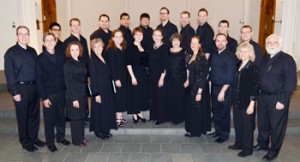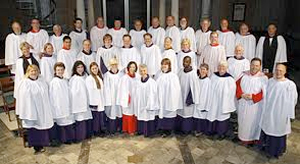by Mike Telin

At 2:00 pm in the Reid Gallery, Quire Cleveland will begin with a work from the 15th century, There is no rose, followed by Josquin des Prez’s Ave Maria, which Duffin describes as one of the composer’s iconic works. The performance continues with an extended piece in carol form from the Court of Henry VIII, Quid petis, o fili? byRichard Pygott. “It’s about Mary speaking to her child,” says Duffin. “It’s an intimate, imagined conversation and very appropriate to the Mother and Child theme.” A Spanish Christmas piece from the 16th Century, E la don don, was printed in Venice in 1556 in the Cancionero de Upsala and survives in only one copy. Duffin says it’s a lively piece that will feature solos by Quire’s male singers.

Duffin and Quire will conclude the program with a 20th century piece, Herbert Howells’s A spotless rose, a translation of the Es ist ein Ros’ entsprungen text of Michael Praetorius. “It’s always been one of my favorite carols so I’m thrilled to have Quire do it.”
The audience will then move to the museum’s spectacular atrium where the Cleveland Orchestra Youth and Children’s Choruses will sing music by Arvo Pärt, Gian Carlo Menotti, John Rutter and Morten Lauridsen, among others.
The afternoon will conclude in Gartner Auditorium with a performance of Britten’s Ceremony of Carols by the sopranos and altos of Trinity Cathedral Choir under the direction of Todd Wilson and featuring harpist Jody Guinn.

2013 marks the centenary of Britten’s birth and Wilson thinks the composer’s choral and vocal music is, “not to use an overused word, but it is unique. Nobody else sounds like Britten. He sets texts that most other composers would not even choose to set to music. He had an uncommon sense for how music and words might best be joined together and certainly you see that in A Ceremony of Carols. All these little gemlike pieces are perfect on their own and they go together to make such a lovely cycle. His music has such integrity as well. It’s honest stuff even though it may not be complex in an overt way. It’s so satisfying for both performer and listener.”
Wilson will conclude the afternoon with music for organ and brass, “ten minutes of real festive stuff at the end just to put a final point on the afternoon. We’ll finish with the Widor Toccata. I’ve got a great version for organ and brass. It will certainly send everybody home with a smile on their face.”
Before the performances, Stephen Fliegel, curator of medieval art, will present a pre-concert talk on Virgin and Child imagery at 1:00 pm in the Recital Hall.
Published on ClevelandClassical.com December 9, 2013
Click here for a printable version of this article.



